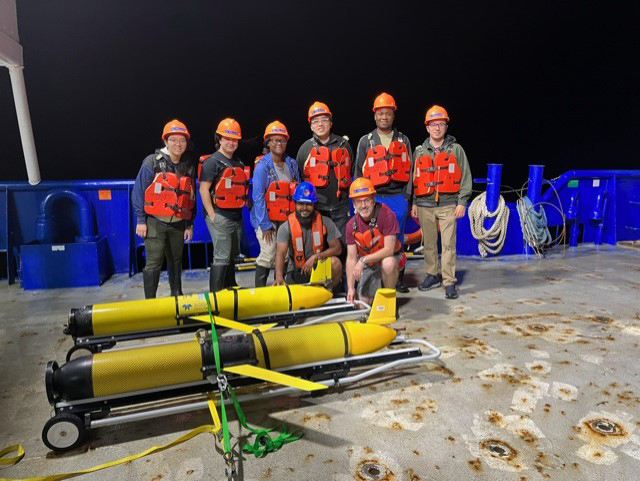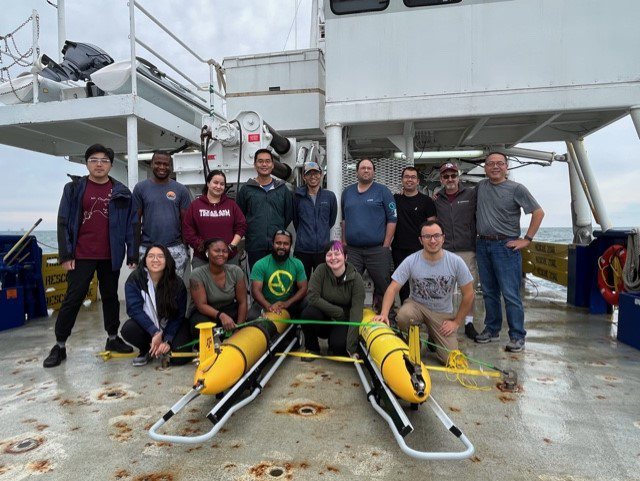
Is ocean acidification affecting the Texas coast’s Flower Garden Banks National Marine Sanctuary? Texas A&M University scientists collected data Oct. 25–28 in the Gulf of Mexico to help answer this question and more, as the fate of the unique and fragile Flower Garden Banks ecosystem is potentially threatened by climate change and acidification.
“Ocean acidification is a process that affects the entire ocean and is driven by the combined effects of climate change and CO2 emissions, which are believed to increase to oceanic pH levels,” said cruise chief scientist Steven DiMarco, professor in Texas A&M’s Department of Oceanography and Department of Ocean Engineering, and Geochemical and Environmental Research Group (GERG) scientist.
Funded by the Ocean Acidification Program (OAP) of the National Oceanographic and Atmospheric Administration (NOAA) and sailing on the RV Pelican, the four-day research cruise investigated the impact of ocean acidification in the coastal ocean environmental of the northwestern Gulf of Mexico. It is the third of four planned cruises, with two completed in 2021 and one upcoming in February 2023.
“The decreased pH levels can have catastrophic effect on marine organisms, particularly calcifying organisms that build and maintain shells, skeletons, and calcium carbonate structures,” DiMarco said.
Located about 100 miles off the coasts of Texas and Louisiana, the Flower Garden Banks sanctuary spans 17 separate reefs and banks, including thriving shallow-water coral reefs, algal-sponge communities, and deeper mesophotic reefs full of black coral, octocoral and algal nodule habitats. Together, the reefs create a chain of protected habitats for ecologically and economically important species across the northwestern Gulf of Mexico.
The project’s research and analysis thus far have led to a new scientific understanding of how carbon dioxide emissions in the atmosphere, large river runoff and changes in ocean currents are all impacting the coastal environment, said Xinping Hu, lead principal investigator and Chair for Ecosystem Science and Modeling at the Harte Research Institute for Gulf of Mexico Studies who is also an associate professor at Texas A&M–Corpus Christi (TAMU-CC).
Hu notes that the combination of using state-of-the-art autonomous ocean vehicles, shipboard observations and numerical models to solve environmental problems is clearly the way forward for future research oceanographic programs attempting to address the long-term impact of climate variability.
DiMarco was accompanied by GERG scientists Uchenna Nwankwo, postdoctoral researcher and chief scientist-in-training Sakib Mahmud, and marine chemist Kelisha Stamps. Oceanography graduate students Xiao Ge, Izzie Wang and Gianna Milton also participated, along with scientists from TAMU-CC; including Hu, lead principal investigator, co-chief; postdoctoral researcher Hang Yin; scientist CJ Staryk, and graduate student Eva Jundt. The research team also included University of Texas at Austin Marine Science Institute postdoctoral researcher Kaijun Lu, Centro de Investigación Científica y de Educación Superior graduate student Jose Sampedro and Boston College postdoctoral researcher Kenji Chen.
In addition to completing scheduled sampling and data collection during the cruise, DiMarco said the team rescued two autonomous ocean gliders in the Gulf of Mexico. The gliders were providing ocean heat observation data that is incorporated into national hurricane prediction forecasts.
“The gliders allow for data collection in offshore conditions that can be unpleasant for researchers,” he said. “The ability to assist in the deployment and recovery of operations assets of multiple national agencies that improve the safety and well-being of human populations is particularly satisfying.”
DiMarco notes that the final NOAA-funded cruise for this project set to sail in February 2023 aboard the R/V Pelican will help climate scientists better understand seasonal impacts and variability of acidification in this sensitive coastal environment.

